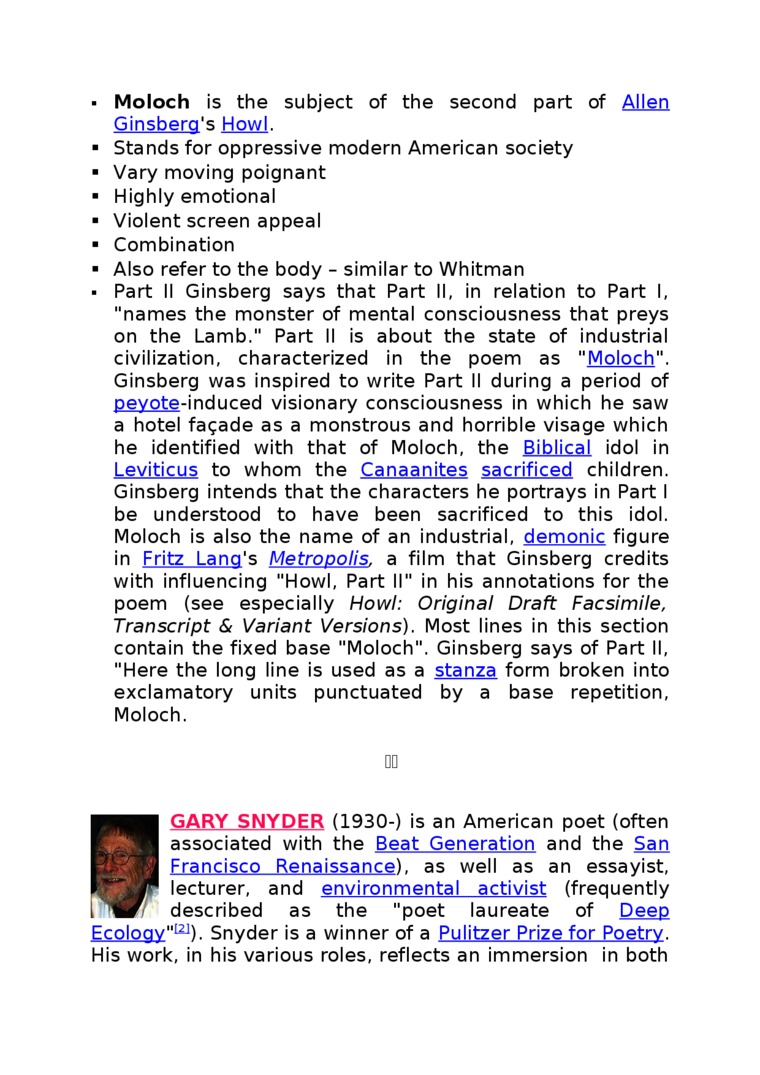107802

• Moloch is the subject of the second part of Allen Ginsbera's Howl.
■ Stands for oppressive modern American society
■ Vary moving poignant
» Highly emotional
■ Violent screen appeal
■ Combination
■ Also refer to the body - similar to Whitman
■ Part II Ginsberg says that Part II, in relation to Part I, "names the monster of mental consciousness that preys on the Lamb." Part II is about the State of industrial civilization, characterized in the poem as "Moloch". Ginsberg was inspired to write Part II during a period of peyote-induced visionary consciousness in which he saw a hotel faęade as a monstrous and horrible visage which he identified with that of Moloch, the Biblical idol in Leyiticus to whom the Canaanites sacrificed children. Ginsberg intends that the characters he portrays in Part I be understood to have been sacrificed to this idol. Moloch is also the name of an industrial, demonie figurę in Fritz Lana's Metropolis. a film that Ginsberg credits with influencing "Howl, Part II" in his annotations for the poem (see especially Howl: Original Draft Facsimile, Transcript & Variant Versions). Most lines in this section contain the fixed base "Moloch". Ginsberg says of Part II, "Here the long linę is used as a stanza form broken into exclamatory units punctuated by a base repetition, Moloch.
OD
r I GARY SNYDER (1930-) is an American poet (often I associated with the Beat Generation and the San I Francisco Renaissance), as well as an essayist, lecturer, and enyironmental actiyist (frequently i W described as the "poet laureate of Deep £ęology,,UJ). Snyder is a winner of a Pulitzer Prize for Poetry. His work, in his yarious roles, reflects an immersion in both
Wyszukiwarka
Podobne podstrony:
280 (54) Survey of numerical methods and algorithms. Part 2Summary Thisbook is the second part of a
CCF20100216�004 12 English Phonetics and Phonology ii) In making the two vowels described above, it
mbs 066 MY BREATHING SYSTEM Dr. Halls Dally’s “ Fuli Cycle of Complete Respiration ” is the second c
CCF20100216�004 12 English Phonetics and Phonology ii) In making the two vowels described above, it
Rys103 The neutral performance models of the part is then subjected to various manufacturing analy
00463 bcaec2dfad584cf6031b64ffdea014 468 Russell The second segment is of shorter duration than th
498 Because there is no homogenous definition of risk in Insurance Theory, the first part of the art
page9 (7) A trim piąte which harmonizes with the color of the interior trim is fitted on the lower p
Abstract A picture is worth a thousand words The subject of our bachelor’s thesis was to create the
12vel07 [ic:Analysis]The difficult part of framed option Controls is placing the option buttons insi
VEGETATION LANDSCAPE AND GEOBOTANICAL REGIONS OF POLAND Summary The subject of the study is a landsc
the terminal part of a core barrel suitable for soft soils Picture 3 The tool is lowered inside the
• The subject of the statement is hidden behind a form of impersonal reflecti
skanuj0267 OLIYIA 2 shuttles The upper part of thc wing is madę in 2 rounds. The rings b - B are tat
47632 Tomicus minor 1 (2) Notę: In T. minor the second row of setae is complete present here JW
slider assy Slider assembly The trickiest part of building the slot mortising machinę is assembling
więcej podobnych podstron